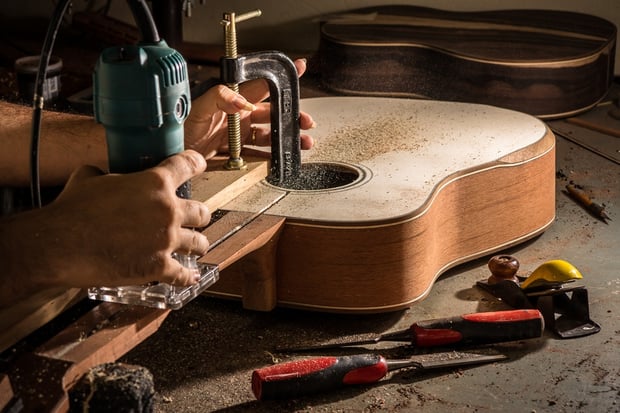 Image via shutterstock.com
Image via shutterstock.com
The truss rod is the perennial scapegoat of guitar problems. The reason for this may be the fact that it's easy to access and requires only one tool to adjust on most guitars. Virtually every guitar is going to experience problems related to a truss rod on a seasonal basis, but some guitarists blame it for everything from weak tone to faulty tuners.
The only problem that any guitar will have that can be fixed with a truss rod adjustment is neck bowing. Humidity and temperature changes are the primary causes for bowing, and any piece of wood is going to be affected by them (just like a door that tends to stick in the summer).
If you think you have a truss rod problem, there's only one check that will rule out all other factors: play every single fret on every single string with the guitar unplugged. If you hear buzzing, or if the fret fails to sound a note, then your guitar neck has bowed upward toward the strings. This means that you need to loosen the truss rod. Grab yourself the appropriate Allen key and give it a turn to the left. (Truss rods work on the "lefty loosey, righty tighty" principle, like virtually all screws and bolts.) Keep in mind that whenever you're adjusting, the rod will never need a full turn. In fact, it probably won't even need a half turn. Improperly adjusting the truss rod can irreparably damage your neck, so if you're uncomfortable with that risk, it may be best to leave the repairs in the hands of a professional.
The other problem that adjusting the truss rod can fix is when your neck bows away from the strings. While you won't experience any fret buzzing, you'll notice that your guitar's strings have risen away from the neck significantly. Typically, this is most noticeable between the seventh and 12th frets. In some cases, you'll actually be able to see the curve in the neck if you look at it in profile. You've probably guessed that this means the truss rod now needs to be tightened. This fix is the same as before, except now you're turning the rod to the right. If the key isn't turning the rod, then you shouldn't try to muscle it. This may indicate a problem that requires neck removal. That's not the end of the world, but it's definitely something you should have done professionally. Also, if you strip the bolt on the truss rod (hard to do, but possible) your guitar will be in need of some serious repairs.
Apart from neck bowing, there are really no other reasons that you should touch the truss rod. The task should need to be done, at most, a couple of times a year depending on where you live.
The last thing I'll note is that truss rods should never be used to adjust the action on your guitar. Raising the strings for slide guitar or lowering them for shredding should be accomplished with bridge adjustments only. Save your time and money by getting an Allen key and adjusting your neck by yourself. Just be sure that the problem with your guitar really is neck bowing first.
Matthew Wendler is a blogger and multi-instrumentalist from New Jersey. He specializes in guitar, bass guitar, and bagpipes, and is passionate about writing both professionally and for enjoyment. His personal blog can be followed on Twitter at @ymiatvmi.







